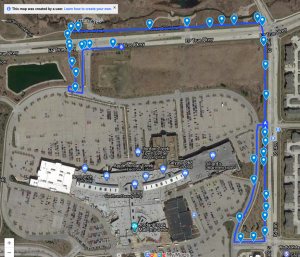 Waukee APEX’s Exploration of Health Sciences and Medicine team was recently given the opportunity to work with Abigail Chihak at the Dallas County Health Department on a walk audit. This project was initially planned to take place in the spring but was postponed due to the school district’s transition to online learning. With the COVID pandemic changing on a daily basis, Abigail brainstormed ways in which to complete this project this semester in a semi-virtual environment.
Waukee APEX’s Exploration of Health Sciences and Medicine team was recently given the opportunity to work with Abigail Chihak at the Dallas County Health Department on a walk audit. This project was initially planned to take place in the spring but was postponed due to the school district’s transition to online learning. With the COVID pandemic changing on a daily basis, Abigail brainstormed ways in which to complete this project this semester in a semi-virtual environment.
APEX’s Katelyn Woodward, Jayna Hays, and Haley Boyd partnered with Chihak to complete the walk audit earlier this month. The purpose of any walk audit is to benefit the local community and help remove any barriers to citizens getting out and enjoying local walking paths and trails. During a walk audit, participants will take into account safety features such as lighting and crosswalks, ADA compliance and accessibility for all abilities and modalities (i.e. strollers, wheelchairs, etc.), and the quality of sidewalks and/or trails. Those conducting the audit will make notes along the assigned path or trail of anything that needs to be repaired or improved and then identify some easy solutions as well as some long term projects that might include replacing areas of a sidewalk or adding lighting to trails.
In order to complete this project, Katelyn, Jayna and Haley were given a specific route in Dallas County to walk and then make notes of problem areas along the way. Katelyn, the project lead, explains, “Our walk audit route covered a mile and a half near the Jordan Creek Mall area. While walking, we took pictures of the good parts of the sidewalk and spots where improvements could be made. We then uploaded those pictures to 40 points on the map. We were able to add descriptions to highlight really good points of the walk path and spots where improvements are needed.”
To complete the project and present their findings, the team is finishing an After Action Report (AAR), which includes a graphic organizer of problems and solutions, along with difficult and easy fixes. They are also describing the good parts of the walk path in order to motivate people to use the paths for transportation and walking to be more active.
Chihak describes the overall project work as a success and expresses how the impact on the community is very positive. “I was really excited to bring this project to APEX to help students see that health is more than just healthcare. This project really gets at the social determinants of health and the built environment; it blends skills of urban planning and public health.” She adds that, “the student associates have done a great job adapting a traditionally in-person experience to the virtual platform, and by doing so, they were able to bring my vision to reality.”
While project work might look different this term due to the ongoing pandemic, our APEX program is grateful for the continued partnership of the Dallas County Health Department. Katelyn Woodward expressed her excitement for being involved with the walk audit project. Katelyn explains, “my team looked at many studies about how walking, even for just 30 minutes a day, has many benefits such as lowering blood pressure, promoting weight loss, improving mood, maintaining healthy joints, and improving sleep quality. Hopefully, with our findings, citizens of Dallas County will walk more in order to improve their health and ultimately live a better life.”
